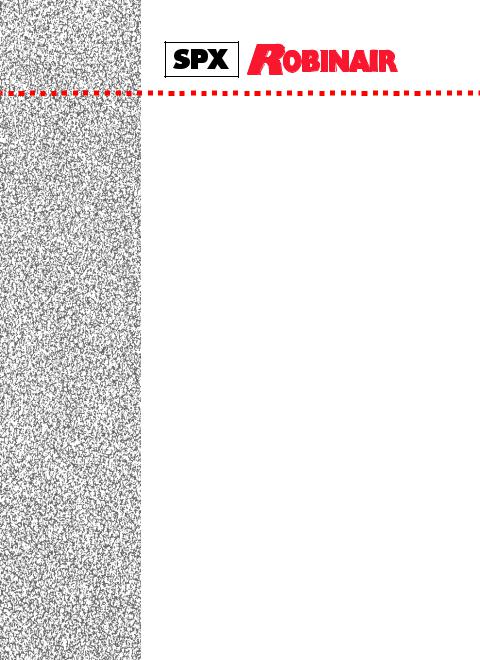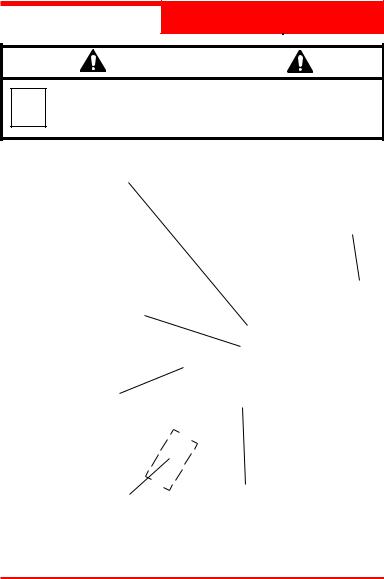Robinair 16600 User Manual [en, de, es, fr, it]

16600
Operating Manual — English |
|
Refrigerant Leak Detector .......................... |
1 |
Manual de Operación — Spanish |
|
Detector de Fugas de Refrigerante ............ |
7 |
Manuel d’utilisation — French |
|
Détecteur de fuites de frigorigène .............. |
13 |
Bedienungsanleitung — German |
|
Kältemittel-Lecksuchegerät ........................ |
19 |
Manuale dell’operatore — Italian |
|
Sensore di perdite di refrigerante ............... |
25 |

|
Table of Contents |
Introduction ................................................................................ |
1 |
Controls and Indicators ............................................................... |
2 |
Features ....................................................................................... |
3 |
Operation .................................................................................... |
4 |
Maintenance ............................................................................... |
5 |
Replacement Parts ...................................................................... |
6 |
Specifications ............................................................................. |
6 |
Introduction
The 16600 is an electronic leak detector used to detect refrigerant leaks in air conditioning and refrigeration systems. It features a sensitivity selection switch which allows it to be used with CFCs and HCFCs at one setting and HFCs at the other. The unit is able to detect leaks smaller than 1/2 ounce per year.
Other features include audible and visual leak indicators, a volume control, a threshold balancing control and a 16" gooseneck probe, which holds its position for one-handed operations. When the unit is not being used, the probe wraps into a retaining clip on the back of the case.
(2N08) Refrigerant Leak Detection Equipment Design Certified by Underwriters Laboratories, Inc.® to meet SAE J-1627 (1993) for R-12 and R-134a refrigerants.
16600 Refrigerant Leak Detector |
1 |

Description
Controls and Indicators
ON/OFF and BALANCE—The same control turns on the unit and gives you infinite control for eliminating background contamination to find leaks fast.
VOLUME—Allows you to adjust the audible leak signal to the appropriate volume for the working conditions.
SENSITIVITY LEVEL—The 16600 can be used for a wide range of refrigerants, but because of different properties of the refrigerant, the correct sensitivity level should be selected. Here are guidelines:
•Level 1—HFCs such as R-134a, HP 62, AC 9000, AZ 20, and AZ 50 (refrigerant blends made up primarily of HFCs)
•Level 2—CFCs and HCFCs such as R-12, R-22, R-500, and R-502 (refrigerant blends made up primarily of CFCs and HCFCs).
If you are not sure which refrigerant is in the system, start with Level 2 and change to Level 1 if you have trouble pinpointing the leak after balancing the leak detector several times.
VISUAL LEAK INDICATOR—The LEDs light up to show increasing levels of concentration. One LED means a minimal amount of refrigerant is reaching the sensor; when all LEDs are lit, there is a sizeable leak or concentration. The LEDs illuminate in sequence from bottom to top.
LOW BATTERY INDICATOR—If only the top LED is lighted, the batteries are low and should be replaced.
AUDIBLE LEAK INDICATOR—The normal operating sound is a steady ticking. As you move the probe closer to a leak, the tone will change to a faster ticking sound and then to an alarm sound (the loudness of this indicator can be adjusted using the volume control).
2 |
© 2000 Robinair, SPX Corporation |

Features
WARNING
Wear safety goggles when working with refrigerants. Contact with refrigerants can cause eye injury.
Audible and Visual Leak Indicators—An alarm increases in frequency as the tip nears a high concentration of refrigerant. LEDs light up to indicate a leak and refrigerant concentration.
Sensing Selection Switch—
Slide the switch to Level 1 or Level 2, depending on the type of refrigerant in the system.
Volume Control—Adjust the audible signal to the volume that’s right for the background noise in the shop or at the job site.
Battery Door—Located on the back side of the handle, the door is easy to remove to change batteries.
One-Hand Operation—
The 16" gooseneck probe holds its position, so you can operate the detector with one hand.
Threshold Balancing Control—Gives you infinite control for eliminating background contamination, so you can zero in on the leak site.
16600 Refrigerant Leak Detector |
3 |

Operation
The first time you use the 16600 leak detector, install the batteries before turning on the unit. Four “AA” alkaline batteries are included (see “Maintenance Instructions”).
1.Remove the gooseneck probe from the retaining clip on the back of the leak detector case.
2.Turn the ON/OFF switch to ON.
3.Select the sensitivity level by sliding the switch to either the “1” setting or the “2” setting.
4.Adjust the balance. Turn the BALANCE control up to a loud alarm sound, then turn it down until you hear a slow, steady ticking.
5.Begin searching for the leak. The recommended scan rate is two (2) inches per second with the sensing tip as close as possible to the area being searched. Run the probe under tubing and check carefully around bends, fittings, and other typical leak points.
TIP: Refrigerant is heavier than air, so check for leaks at the top of the system first, working your way toward the bottom. In strong wind conditions, you may need to shield the area before searching for leaks.
6.To pinpoint a leak, you may need to adjust the balance. When you are near a concentration of refrigerant, the alarm tone will sound. Keep the probe in the same position and turn the balance control down until you hear the ticking sound. Then continue searching for the leak. You may need to balance the unit several times if there is a large leak and refrigerant has accumulated.
7.If you find more than one leak, or if you suspect more than one, repair the larger leak(s) first so pinpointing the smaller leak is easier.
4 |
© 2000 Robinair, SPX Corporation |

Maintenance
Cleaning/Replacing the Sensing
Tip
The sensing tip is the most critical component of the leak detector. Periodically it may become clogged with dirt, grease, and oil. If the tip looks dirty, and you have difficulty pinpointing a leak or experience constant false alarms, the tip probably needs to be cleaned or replaced.
To Clean the Tip:
1.Turn the ON/OFF switch to OFF.
2.Unscrew the tip from the gooseneck probe.
3.The tip can be cleaned in most vaporizable solvents, such as denatured alcohol. We recommend using a solvent, but if this is not possible, wash the tip in warm, soapy water. Rinse thoroughly with clear water and allow to air dry completely before reinstalling the tip on the probe.
IMPORTANT! Allow adequate time for the tip to air-dry before using the leak detector. Moisture in the tip can trigger false alarms.
Be sure your hands are clean and dry. Be careful not to contaminate the tip with perspiration, grease, hand cleaners, etc.
To Change the Tip:
An extra tip comes with the unit. You can also buy replacement tips. One extra tip stores in a special slot inside the battery compartment. Follow the instructions in “INSTALLING/REPLACING BATTERIES” to open the battery compartment.
1.Turn the ON/OFF switch to OFF.
2.Unscrew the tip from the gooseneck probe.
3.Thread the new tip onto the probe until it’s finger-tight. Do not overtighten.
4.When the leak detector is not in use, wrap the gooseneck probe into the retaining clip to protect it.
16600 Refrigerant Leak Detector |
5 |

Maintenance
Installing/Replacing Batteries
Your unit uses four (4) “AA” alkaline batteries. The batteries should be replaced if the top LED (beside the words LOW BATTERY) lights up when the unit is first turned on. The battery compartment is located on the back of the case.
1.Turn the ON/OFF switch to OFF.
2.Remove the screw holding the battery compartment door. If you are replacing batteries, remove the old batteries.
3.Place the new batteries in the battery compartment, following polarity indication.
4.Replace the battery compartment door, and secure the door with the screw.
Replacement Parts
16503 |
Replacement Sensing Tip |
16604 |
Battery Compartment Door |
Specifications
Power Supply |
.............................................................. 4 “AA” alkaline batteries |
Sensitivity ..................................................................... |
Less than 1/2 oz. per year |
Battery Life ................................................................... |
Approximately 25 hours |
Dimensions ........................................................................ |
81/2"L x 31/4"W x 2"D |
............................................................................... |
(21.59 cm x 8.26 cm x 5 cm) |
Probe Length ...................................................................... |
16 inches (40.6 CM) |
Weight ................................................................. |
1.14 lbs. (.52 kg) with batteries |
6 |
© 2000 Robinair, SPX Corporation |

|
Contenido |
Introducción ................................................................................ |
7 |
Controles e Indicadores .............................................................. |
8 |
Características ............................................................................. |
9 |
Operación ................................................................................. |
10 |
Mantenimiento ........................................................................... |
11 |
Partes de Repuesto .................................................................... |
12 |
Especificaciones ....................................................................... |
12 |
Introducción
El 16600 es un detector electrónico de fugas usado para detectar fugas de refrigerante en sistemas de aire acondicionado y refrigeración. Tiene un conmutador para seleccionar la sensibilidad lo que permite que en el un ajuste sea usado con CFCs (CloroFúorCarbonados)y HCFCs y en el otro con HFCs. La unidad es capaz de detectar fugas menores a 1/2 onza por año.
Otras características incluyen indicadores de fugas sonoros y visuales, control de volumen, control del balance de umbral, y una sonda exploradora cuello de ganso de 16" al mantenerse en posición permite manipular la unidad con una mano. Cuando no se usa la unidad, la sonda exploradora se la dobla y se la asegura en la presilla de sujeción atrás en la caja.
UL (2N08) Diseño del Equipo Detector de Fugas de Refrigerante Certificado por Laboratorios Underwriters, Inc. para que cumplan con la norma SAE J-1627 (1993) para refrigerantes R-12 y R134a.
16600 Detector de Fugas de Refrigerante |
7 |

Descripcióne
Controles e Indicadores
ENCENDER/APAGAR y BALANCE—El mismo control enciende la unidad y le da un control total para eliminar la contaminación de fondo y encontrar rápidamente las fugas.
VOLUMEN—Le permite regular la señal sonora de la fuga al volumen apropiado a las condiciones de trabajo.
NIVEL DE SENSIBILIDAD—El 16600 puede ser usado para una amplia gama de refrigerantes, pero debido a las diferentes propiedades de los refrigerantes, se deberá seleccionar el nivel correcto de sensibilidad. Aquí algunas guías:
•Nivel 1—HFCs tales como R-134a, HP62, AC9000, AZ20, y AZ50 (Mezclas de refrigerante hechas principalmente con HFCs).
•Nivel 2—CFCs y HCFCs tales como R-12, R-22, R-500 y R-502 (mezclas de refrigerantes hechas principalmente con CFCs y HCFCs).
Si Ud. no está seguro cual refrigerante está en el sistema, empiece con el nivel 2 y si luego de balancear varias veces el detector de fugas tiene problemas en localizar con exactitud la fuga, cambie al Nivel 1.
INDICADOR VISUAL DE FUGAS—Los LEDs se iluminan para mostrar niveles crecientes de concentración. Un LED iluminado significa que el sensor detectó una cantidad mínima de refrigerante; cuando todos los LEDs están iluminados hay una fuga o concentración considerable. Los LEDs se iluminan en secuencia, desde abajo hacia arriba.
INDICADOR DE BATERÍA AGOTADA—Si solamente está iluminado el LED superior, las baterías están agotadas y deberían ser cambiadas.
INDICADOR SONORO DE FUGAS—Un tictac uniforme es el sonido normal de trabajo. A medida que la sonda exploradora se mueve más cerca de una fuga, el tono cambia a un sonido tictac más rápido y luego a un sonido de alarma (la intensidad sonora de este indicador puede ser regulada usando el control de volumen).
8 |
© 2000 Robinair, SPX Corporation |

Características
¡ADVERTENCIA!
Use siempre gafas de seguridad cuando trabaje con refrigerantes. El contacto con refrigerante puede ocasionar lesión al ojo.
Indicadores de Fugas Sonoros y Visuales—Una alarma aumenta en frecuencia a medida que la punta se acerca a zonas de mayor concentración de refrigerante. Los LEDs se iluminan para indicar la fuga y la concentración de refrigerante.
Selector de la Sensibilidad—
Deslice(mueva) el selector al Nivel 1 o Nivel 2 dependiendo del tipo de refrigerante del Sistema.
Control del Volumen—
Regula la señal sonora hasta el nivel de volumen correcto según el ruido de fondo del taller o del sitio de trabajo.
Compuerta de las baterías—
Ubicada en la parte posterior de la agarradera, esta compuerta facilita el retiro de las baterías para su cambio.
Operación con una Mano—
La sonda exploradora de 16" tipo cuello de ganso mantiene su posición de modo que Ud. pueda hacer funcionar al detector sólo con una mano.
Control del Balance de Umbral—Le da a Ud. un control total para eliminar la contaminación de fondo de modo que Ud. pueda en el sitio de trabajo ponerlo en cero.
16600 Detector de Fugas de Refrigerante |
9 |
